UltimateMAME
This one is actually just based off MESS SVN revision 13871, so I’m not 100% sure which MAME version it’s synced to, but it’s post 0.144u4 for sure.
The process is simpler than it’s ever been right now, requiring minimal changes, in essence just a tool to combine the lists, and a new build target. A source diff of the needed changes is here.
I’m simply offering a single package this time, this includes
complete.exe / complete64.exe – 32-bit and 64-bit builds of the combined binary
as well as the rather redundant
mame.exe / mame64.exe – 32-bit and 64-bit builds of just the MAME target
mess.exe / mess64.exe – 32-bit and 64-bit builds of just the MESS target.
32-bit and 64-bit compiles of the tools are included in tools32/tools64 folders too
the full source is in there as well.
You can download that package here. It’s quite big because as mentioned above, I’ve just included all the builds for both 32-bit and 64-bit as well as the source.
To build the complete source do ‘make TARGET=complete’ although it’s recommended you build ‘TARGET=mess’ first if you want all the tools tho as it avoids a minor linker problem with some MESS-specific tools (needs looking into, probably something trivial)
Saturn Puzzle Games
The Saturn was just one of many Sega products which failed to achieve the same heights outside Japan as within it. To many it is considered a failure, beaten hands down by the Playstation, with little of worth to offer. Granted, it might not have been a 3D powerhouse, I’d be hard pressed to actually call it a 3D system, and the arcade ports of various fighters might not be quite as amazingly arcade perfect as some of the fanboys rave on about as if some great injustice has been done to the system, but, it had its fair share of interesting titles, especially in Japan.
Over the last few weeks I’ve been going through the Saturn Software List in MESS, which can be found in the UltimateMAME build to try and get an overall picture of how much of the Saturn library is actually dumped. If you factor out demo versions of games, the situation isn’t too bad, there are only a handful of games which don’t appear to be dumped at all, although frustratingly many are dumped to low standards, some just cheap iso + mp3 rips, even for relatively popular games. Also frustrating is that the Ultraman ROM cartridge (needed by that specific game) doesn’t seem to be dumped at all, that would have been an interesting project to get working moreso than the KOF95 one, which is dumped.
Anyway, needless to say a couple of titles have caught my eye. I’ve always enjoyed puzzle games, everything from the likes of the staple titles of Tetris, Columns, and Puyo Puyo to the more obscure ones. Mushihimetama for example was by far the most interesting of the Cave SH3 games to me as it was a true sequel to the absolutely brilliant Uopoko.

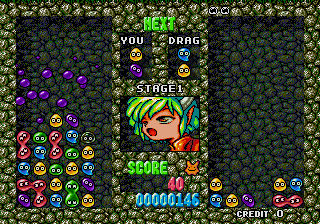
The classics – The Saturn actually has a port of Columns 1 (and the rest) as part of the Sega Ages Columns collection. It seems only Puyo Puyo 2 was ported tho, not the original.
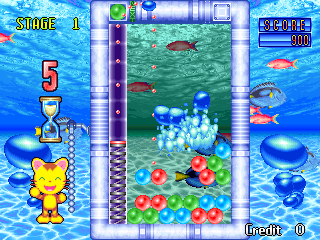
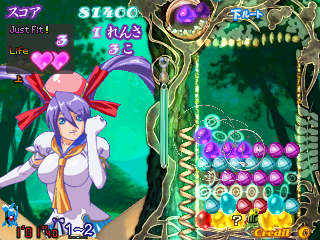
Not Saturn, but two of my absolute favourites Uopoko and Mushihimetama, which I feel could have been influenced by one of the games featured later in the article, keep reading!
Back to the Saturn, amongst the many dating simulations, fortune tellers, JRPGs and board game conversions the Japanese library also has a large selection of Puzzle games. Many of these are arcade conversions which from a gameplay point of view are rather made redundant by the emulation of the actual arcade versions in MAME although some do offer extra modes. Below are a selection of comparison shots.
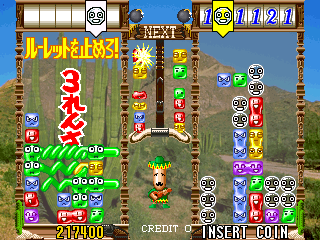
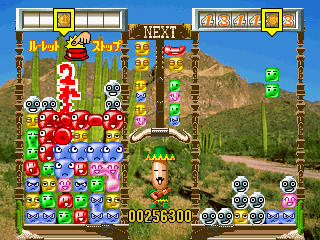
Deroon Dero Dero (Arcade left, Saturn right)
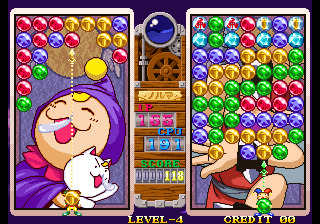
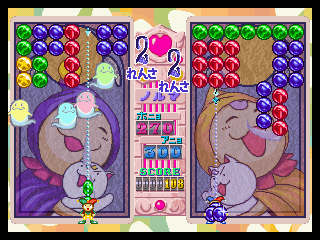
Magical Drop 3 (Arcade left, Saturn right)


Monster Slider (Arcade left, Saturn right) This one is very different, not a straight port at all!
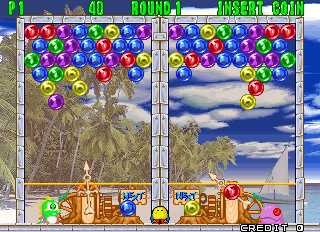
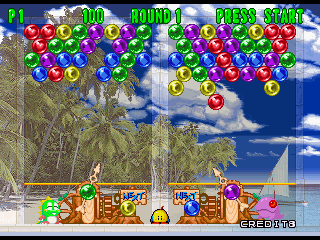
Puzzle Bobble 2X (Arcade left, Saturn right)
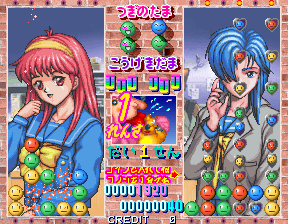
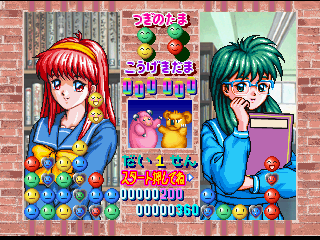
Tekimori Puzzledama (Arcade left, Saturn right)
There are more too. I wanted to include a few more, but the emulation of Mouja seems to be broken in the current version of MAME, and a couple of the Saturn titles don’t work in the MESS driver (Super Puzzle Fighter 2 runs in slow motion even at full framerate) but luckily, for the most part, the emulation of the puzzle style games holds up a lot better than the overall Saturn compatibility in MESS, which is sketchy at best. The Saturn also naturally got conversions of many of the ST-V puzzlers such as Columns ’97, Baku Baku Animal, and Puyo Puyo Sun, as well as ports of number of the C/C2 hardware games (Sega seemed to have had some easy way to either port or emulate Genesis based games on the platform) Interestingly the arcade game Mausuke no Ojama the World does not appear to have been released on the Saturn despite being on ST-V arcade hardware, a real shame because it’s probably my favourite puzzler on the system, the unique mechanic of having to link things diagonally to give them power before you get rid of them make it shine.
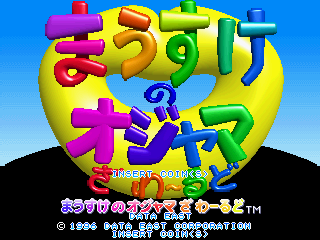
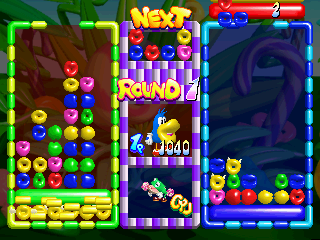
Mausuke no Ojama the World, ran on Saturn hardware in the Arcades, but didn’t get a home release?
None of that is all too interesting on its own tho, games you’ve seen before. Thankfully the Saturn also had a couple of unique puzzlers of its own, maybe not exclusives (I really haven’t checked) but non-arcade conversions nevertheless.
Pastel Muses
Uopoko was mentioned earlier, and that’s what Pastel Muses reminds me of the most. It predates Uopoko by a few years, but relies on a similar game mechanic of having to hold down a button longer to fire your ball projectile further, clearly an idea borrowed from the various pinball and pachinko machines but one which at the time wasn’t extensively used in arcade puzzle games. Pastel Muses differs from Uopoko in that you’re also in rough control of the direction of your projectile, although you’ll often set it once for a level and leave it so the overall feeling is similar, the guide line which you get during the first few levels also vanishes in the same way so you need to get a feeling for the power levels quickly. Did this game actually influence those later Cave titles? You have to wonder, Cave were certainly aware of the Saturn as they produced several games for it.
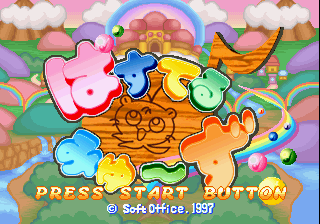
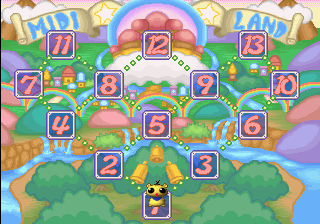

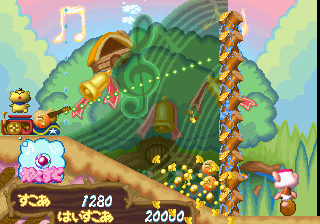
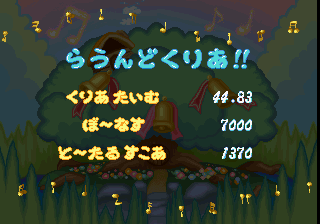
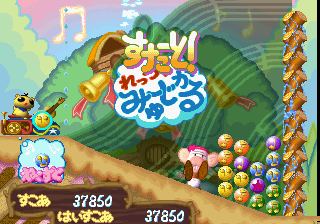
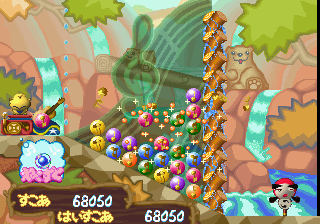
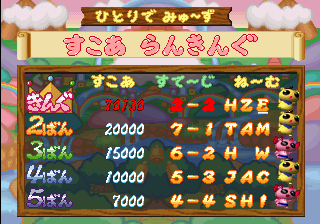
Tenchi Muyou! Rensa Hitsuyou
This one is easy to overlook, the name doesn’t stand out to an English reader as ‘Puzzle Game’ but it actually stands up as one of the better games on the platform. You’re initially presented with a poor quality ‘Pioneer LDC’ video sequence, that alone might be enough to put you off the title or lead you into thinking it’s some poor laserdisc conversion, but persevere, and much better looking attract / title screens arrive.
The game again follows the simple ‘Connect 3’ equal algorithm, the playfield in this case isn’t entirely flat which changes your link patterns a little, but the real twist with this game comes from the water. Rather than your traditional ‘drop lots of blocks on opponent’s attacks which you commonly find in this type of game you instead cause the water level to rise on your opponent’s side of the screen. This has the interesting effect of causing new blocks which aren’t anchored down with the special anchor items to float. It’s a simple change, and truth be told it might even confuse you at first, but once you work out what’s going on it does successfully add a new dimension to a tried puzzle formula. In game this is another really well presented title, and I can have no complaints about either the graphics or the sound. Emulation seems a little slow, running at around 80% speed on my system, which surprises me for such a simple game, it’s likely there is room for some optimization in the driver to help here.
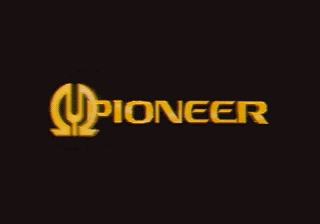
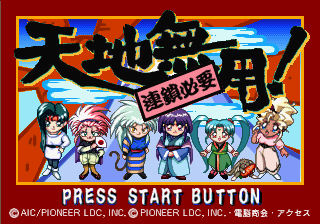

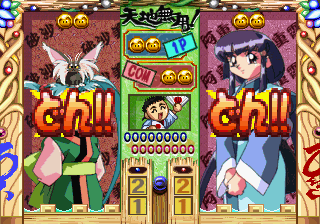
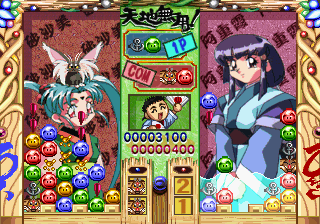
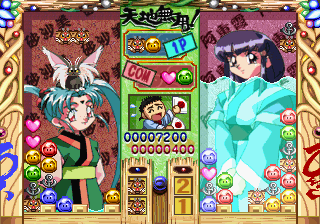

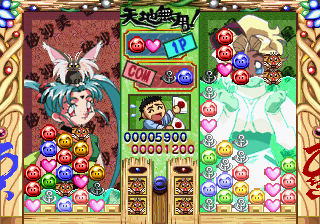
Kururin Pa!
Another block dropper, this one takes the ‘pipe’ block approach, dropping pieces resembling those found in Pipe Dream, although in this case they’re actually ropes, or to be more precise, fuses. Bomb items will drop, too, as will fire icons. Drop the fire on the end of a fuse and any correctly connected blocks will burn, drop it on a bomb and that bomb will explode, lighting any surrounding fuses. It might sound complex, but it really isn’t. Like most games you’re playing against a computer opponent trying to do the same thing, as time goes on the speed increases, but the controls always remain sharp and snappy which is a big plus.
The only thing that really lets the game down is the presentation, and while there is nothing really wrong with the graphics (apart from the Title screen which simply burns your eyes out) they’re very plain, and remain functional rather than fancy. Of course with these types of games it’s really the gameplay that counts, you could create an absolutely gorgeous game, but if it simply offers nothing beyond that it wouldn’t be worth playing, unlike this, which most definitely is.
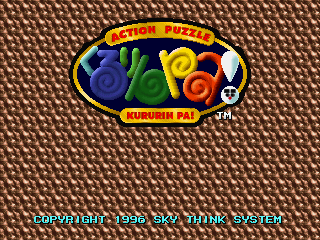
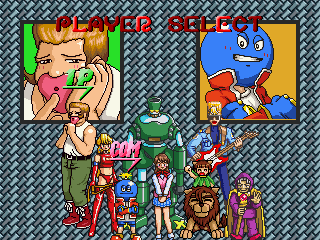
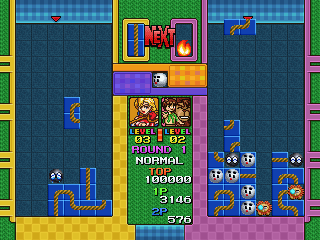

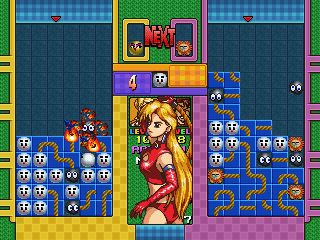
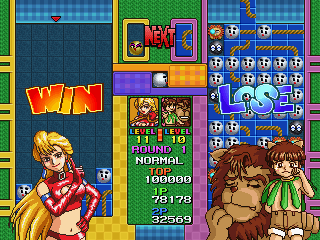
Shingata Kururin Pa!
Shingata Kururin Pa! is actually the sequel to Kururin Pa! and manages to address a good number of the previously raised concerns about the graphics. It’s more stylish, has a lot more animation, and is overall a lot more polished, but somehow it just didn’t seem to play as well, but maybe that’s just me.
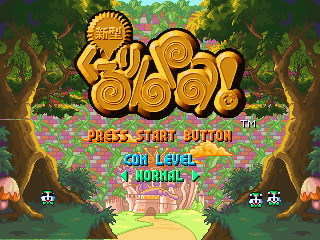
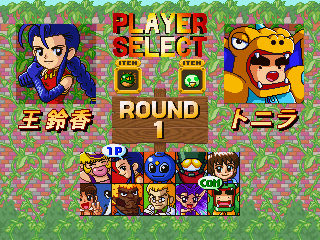
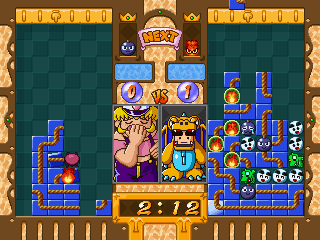
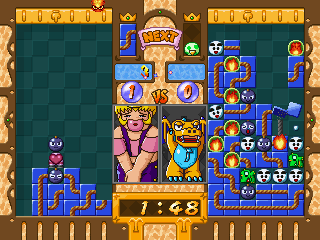
PD Ultraman Link
Ultraman games are usually considered terrible. The Saturn fighter which uses a ROM cart is often ridiculed for how poor it is, and the other Saturn Ultraman releases just appear to be some kind of infobook / FMV game hybrid type things.
Ultraman Link breaks the trend a little, by not actually being terrible, and despite using CG rendered graphics for the most part it even looks good with smooth colour gradients and no ugly dithering. The game, like Kururin Pa uses ‘pipe’ type pieces falling into a pit. The rules here are very different tho, linking 3 or more pipe pieces together causes them to disappear, regardless of colour, although linking blocks of the same colour seems to be most beneficial if I’m understanding the rules correctly. The secret as always is chaining, but because the pipe pieces only have links on certain sides this requires different thinking to your standard stack + chain methods used in the likes of Puyo Puyo; you have to carefully think about where the links are on your pieces rather than the colours.
As a game it seems to play well, I can’t say I’ve put as much time into this one as the others mentioned, but the brief times I played it I did enjoy it, and will be coming back to it again at some point.

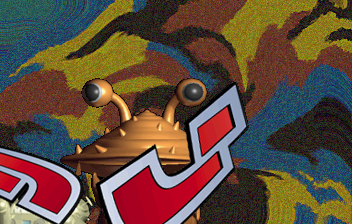
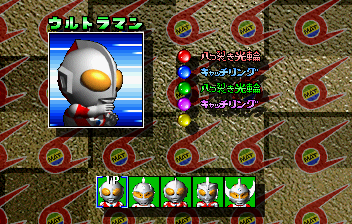

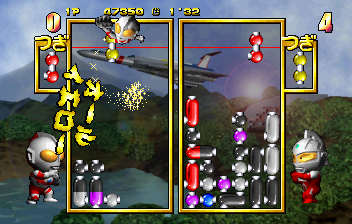
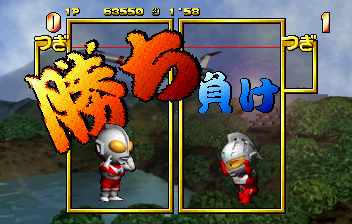

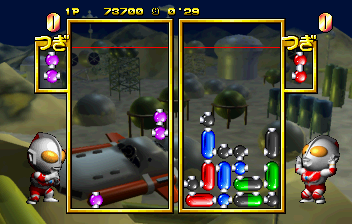
Pappara Paoon
Ecole Software, I’ve heard of them, they were behind the rather popular Melty Blood games. It surprises me therefore that this title seems so bad. It feels like a poor public domain Amiga game coded in AMOS. It’s ugly, has horrible controls, and a from what I can tell, a completely uninspired game design.
The gameplay is horizontal, you link X pieces in a row much as you would in Columns, all while your opponent is trying to do the same. I might have to come back to this one later, because I feel I must be missing something, or letting the poor presentation values sway my judgement on the quality of the game too much.
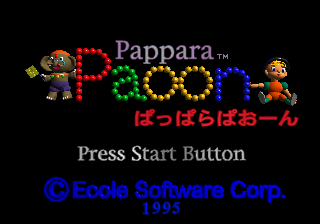
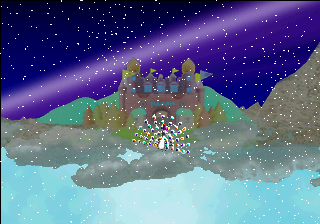
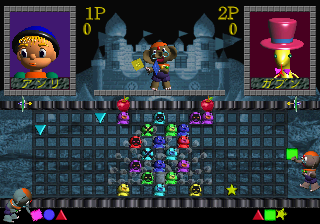
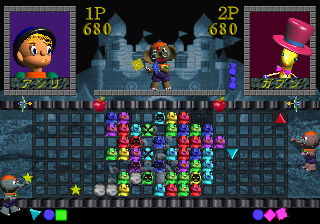
Tsuukai! Slot Shooting
From looking at screenshots I thought this might be some kind of Puzzle game. After playing it, I’ve concluded that it really doesn’t seem to be, you just seem to have to shoot the falling crabs before they have time to accumulate below. Not a great deal of fun.


Make Your Own
The Saturn also has a piece of software designed to help you make your own games of this type. Sadly it’s entirely in Japanese, full of menus, and I don’t understand a word of it. I couldn’t even work out if it comes with any built in games, a real shame this kind of thing didn’t get released outside of Japan. It’s called “Ochige Designer Tsukutte Pon!” apparently.
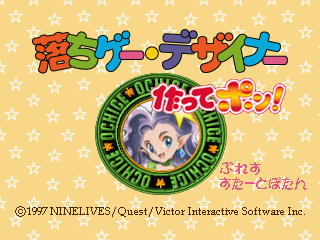
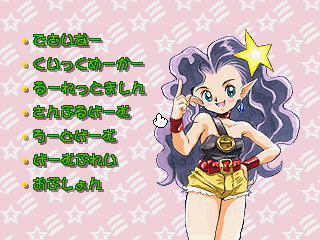
Others
There were other puzzle games on the Saturn which haven’t been mentioned yet too. The Saturn had its very own version of Tetris dubbed “Tetris S”, but that doesn’t work in MESS / UM yet. “Heisei Tensai Bakabon Susume! Bakabons” looks like it could be worth playing too, but the inputs don’t work.
There were also a good number of ‘Puzzling’ games which don’t quite fit in this genre due to being more action based. Things like ‘Noon’ and ‘Tama’ both look to be worth playing, the former runs in MESS / UM, the latter again lacks working inputs.
Overall if you enjoyed this genre the then a Japanese Saturn was well worth owning, between the excellent arcade conversions and the original titles there’s enough puzzle action to keep you busy for a long, long time.